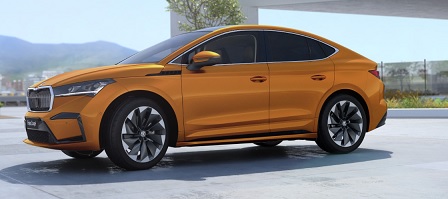Key specs
Skoda Enyaq iV (Coupe, SUV) Enyaq Coupe iV 2022,2023,2024,2025,2026
What is the body type, Skoda Enyaq Coupe iV 80 82 kWh (204 Hp) 2022?
Coupe, SUV, 5 Doors, 5 Seats
How fast is the car, Skoda Enyaq Coupe iV 80 82 kWh (204 Hp) 2022?
160 km/h 99.42 mph
How many cylinders, Skoda Enyaq Coupe iV 80 82 kWh (204 Hp) 2022?
Electric,
What is the drivetrain, Skoda Enyaq Coupe iV 80 82 kWh (204 Hp) 2022?
Rear wheel drive,
How long is this vehicle, Skoda Enyaq Coupe iV 80 82 kWh (204 Hp) 2022?
4653 mm
183.19 in.
How wide is the vehicle, Skoda Enyaq Coupe iV 80 82 kWh (204 Hp) 2022?
1879 mm
73.98 in.
What is the curb weight, Skoda Enyaq Coupe iV 80 82 kWh (204 Hp) 2022?
#N/D
Skoda Enyaq iV (Coupe, SUV) Enyaq Coupe iV 2022,2023,2024,2025,2026 Specs
General information
| Brand |
Skoda |
| Model |
Enyaq iV (Coupe, SUV) |
| Version |
Enyaq Coupe iV |
| Engine version |
80 82 kWh (204 Hp) |
| Year production start |
2022 |
| Vehicle type |
Coupe, SUV |
| Acceleration 0 - 100 kmh sec |
8.7 sec |
| Overall length mm - inch |
4653 mm
183.19 in.
|
| Doors |
5 |
| Top Speed |
160 km/h 99.42 mph |
Engine specs
| Engine position and orientation |
Rear axle, Transverse |
| Cylinders |
Electric |
| Fuel type |
Electricity |
| Powertrain architecture |
BEV (Electric Vehicle) |
| Electric motor power |
204 Hp
|
| Electric motor torque |
310 Nm 228.64 lb.-ft.
|
| Engine location |
Rear axle, Transverse
|
| Total available power |
204 Hp
|
| Totale available torque |
310 Nm 228.64 lb.-ft.
|
Transmission and Drive system
| Drive configuration |
Rear wheel drive
|
Brakes
| Front brakes |
Ventilated discs |
| Anti-lock brake system |
ABS (Anti-lock braking system) |
Steering
| Steering type |
Steering rack and pinion |
Passenger
| Passengers seats |
5 |
| Trunk space min liter | cu. Ft. |
570 l
20.13 cu. ft.
|
| Trunk space max liter | cu. Ft. |
1004 l
35.46 cu. ft.
|
Dimensions
| Overall length mm - inch |
4653 mm
183.19 in.
|
| Overall width mm -inch |
1879 mm
73.98 in.
|
| Overall height mm -inch |
1622 mm
63.86 in.
|
| Wheelbase mm - inch |
2765 mm
108.86 in.
|
| Track width front mm - inch |
1587 mm
62.48 in.
|
| Track width rear mm - inch |
1565 mm
61.61 in.
|
| Coefficient of drag |
0.234
|
Fuel economy
| Fuel economy-190 |
Autonomy WLTP up to 534 km |
Engine type
Electric
https://www.thecarspec.com/components/engine/electric

